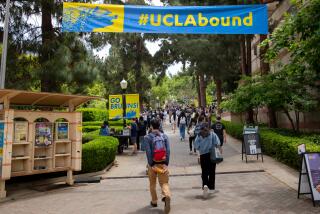Board Not Bowled Over by ‘Bathroom’ Building : Architecture: Rancho Santiago College officials complain that the new $1-million library annex does not fit the campus. Cracks, stains and smell are also noted.
- Share via
SANTA ANA — For $1 million, Rancho Santiago College officials say, they expected an attractive library annex that would fit the campus’s earth tones.
Instead, they got a gleaming, blue-and-white tile building that people on campus have dubbed “the bathroom.”
In addition, the building has hairline cracks, stained brick, a chemical smell and unsightly blobs of cement in places. But those things, most everyone agrees, are not uncommon and easily fixed.
The bigger problem, Trustee Enriqueta Ramos said, is: “It just looks like someone put a bathroom out there.”
Although the project’s physical flaws are expected to be remedied within the next few weeks, several members of the Board of Trustees remain upset over the building’s design. With bright tiles and white walls, the building resembles none of the campus’s other structures, nor the artists’ rendering.
At a board meeting Monday, trustees grumbled about the cracks and the smell and debated the building’s design.
“In the future, before we complete a building and occupy it, the board should get to go through it,” Board President Brian Conley said. “It doesn’t match (its surroundings) and I’m very disappointed.”
But Trustee Carol Enos countered that “so much is a matter opinion and taste, and it’s hard to qualify whether it’s in place or out of place.”
On a 4-2 vote, the board then approved a notice of completion for the project. The notice signifies that work on the building is substantially finished although routine work such as fixing the cracks and discolored brick remain. Trustees Conley, Enos, Tom Saenz and Michael Ortell voted in favor of the notice and Trustees Charles W. (Pete) Maddox and Ramos opposed it.
Maddox and Ramos said they hoped to signal their displeasure with the architect over the design. However, the staff noted that the architect, Newport Beach-based Blurock Partnership, already had been paid.
Conley and Maddox had emphasized as early as 1991 that the building should match its surroundings. Although the board reviewed tiles and other materials to be used in the construction in 1992, Maddox said the artist’s rendering, which uses muted tones, differs substantially from the bold colors of the finished product.
Alan Smith, senior partner for Blurock, said that artists’ renderings are not always perfectly representative of colors to be used. The sample materials are representative, he said, but people sometimes have difficulty visualizing them in a final product.
“We’d be happy to talk with (board members) and identify their concerns and see what can be done, if anything,” he said.
On Wednesday, district workers surveyed numerous hairline cracks in plaster that stretched more than 20 feet, discolored bricks, and walls and windows spattered with dried gobs of cement. The 5,500-square-foot library addition has been occupied since last month and used for student testing.
Bob Brown, director of building and maintenance, emphasized that the building’s flaws were merely cosmetic and that the structure “is built like a tank.” The cracked plaster and stained brick would be repaired within the next few weeks, he said.
Bob Partridge, administrative dean of facility planning, said he was generally pleased with the work done by Fischbeck Construction Inc. of Anaheim, the general contractor. He also said the building has required fewer last-minute corrections, like fixing cracked plaster, than other recent projects on campus.
As for the chemical smell, Brown said it was from the new paint and carpet. It poses no health threat and will dissipate soon.
Maddox conceded that, “in all fairness, there’s always detail work at the end of a job that needs to be done, but I don’t think any amount of detail work is going to change the fact that (the building) doesn’t fit the architectural theme of the district.”
Trustee Saenz, who was elected to the board late last year, said the district should avoid similar problems in the future by touring buildings that are similar in design.
As for the current building, he added, “it’s there and we have to accept it at this point.”
More to Read
Sign up for Essential California
The most important California stories and recommendations in your inbox every morning.
You may occasionally receive promotional content from the Los Angeles Times.










